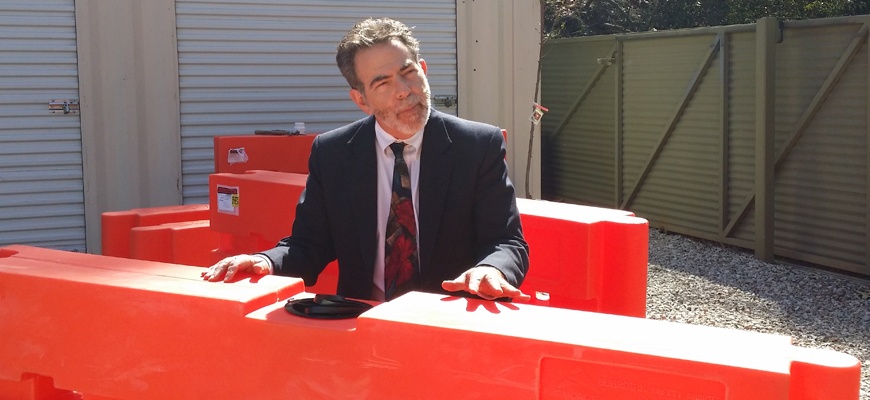The UCLA Anderson Economic Forecast brings business and water leaders together to consider the implications for the city’s water supply in light of the drought and projected long-term water shortages. I’ve been invited to share an emerging approach that with investment, could help not only with the immediate drought, but create a substantial part of our long-term water supply.
There are big choices to be made prior to investing billions on infrastructure to help the region meet its urgent water-related needs, adapt to increasing climate threats and strengthen its economy. Instead of deferring to traditional, less sustainable approaches, I will be sharing how captured rainwater could comprise nearly half of LA’s water supply.
Despite last year being one of the driest on record, LA still received 3.6 inches of rain, creating 13.68 billion gallons of polluted water that was swept straight out to our ocean. That’s about 6,500 gallons per person for all the 4 million residents of LA!
Given this perspective, LA’s leaders have a special opportunity to choose to invest in a proven, cost-effective distributed rainwater harvest infrastructure model to meet the city’s urgent needs. This decision will not only lead the way to an environmentally sustainable city, but also support the creation of local jobs to feed back into LA’s economy.
Despite last year being one of the driest on record, LA still received 3.6 inches of rain, creating 28 billion gallons of polluted water that was swept straight out to our ocean. That’s about 6,500 gallons per person for all the 4 million residents of LA!
Given this perspective, LA’s leaders have a special opportunity to choose to invest in a proven, cost-effective distributed rainwater harvest infrastructure model to meet the city’s urgent needs. This decision will not only lead the way to an environmentally sustainable city, but also support the creation of local jobs to feed back into LA’s economy.
Wasted water
We believe that we live in a desert, but we don’t. LA’s climate is actually Mediterranean semi-arid, receiving on average of 10-15 inches of rain per year.
That may not seem like much, but according to the L.A. Bureau of Sanitation, 1 inch of rainfall translates to 7.6 billion gallons of often polluted runoff that goes straight into storm drains and the ocean from our roofs, driveways and paved surfaces.
This is no one’s fault—it’s the way the city was designed over 100 years ago.
On this front there is very good news
LA’s people have shown that they can change, quickly and permanently.
In the last major drought in the late 1970s, due to a great public education campaign and water restrictions, Angelenos cut their water use by 30%. In part from that, even over 30 years later– with 1 million more people living in the city –LA uses less water than it did before that drought.
LA’s agencies have invested in distributed water conservation technologies, providing incentives for people to install new technologies including low-flow toilets, showerheads and efficient washers. These have been mainly for indoor use, and have made a huge impact. But more is needed, and rainwater – even in a drought – is a great untapped resource.
Looking to Australia for solutions
Australia experienced a 12-year dry spell in the 1990s—the Millennium Drought. The Australian people were provided with sustainable incentives along with some deterrents, like water restrictions. With these, residents rose to the occasion and helped save their communities and country.
Government rebates enabled the rapid implementation of distributed rainwater harvesting, with millions of cisterns installed in homes across Australia’s major cities. The community responded, and now:
- Over 45% of homes now have rainwater cisterns in Adelaide—a city with similar climate and rainfall to LA.
- 30% of homes are outfitted with cisterns in Melbourne, Sydney and Brisbane.
- In Brisbane, water use dropped from 80 gallons per person per day to 33 gallons, with similar results throughout the country.
- According to the DWP, LA customers use 129 gallons per person per day.
- LA private residents use 89 gallons per person per day.
Using the combination of public and private education programs and restrictions, Australians achieved radical and lasting conservation rates in major cities across the country, proving that real change is in reach.
How to close the gap?
Will we in LA have the vision and courage to seriously get on this path and take it to scale? How will we respond to the current drought emergency and our long-term water crisis? Will we invest in a resilient and sustainable future?
We at TreePeople make rainwater harvesting and outdoor water conservation tools and information available to the people of LA. Our work empowers Angelenos and local agencies to be more sustainable, capture rainwater, rip out turf and create beautiful native landscapes.
If we combine distributed rainwater harvesting, conservation and landscape transformation with the other priorities for LA, like cleaning up the San Fernando Basin’s aquifer and increasing the use of recycled water, then we can achieve at least a 50% reliable local water supply. Let’s work together to follow in the footsteps of our colleagues Down Under and create a drought-smart community that can adapt to the imminent, dry future ahead.

